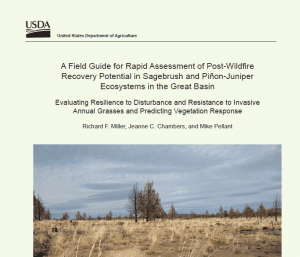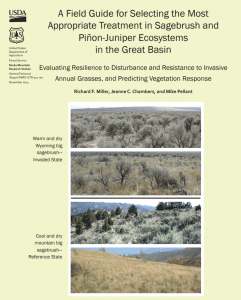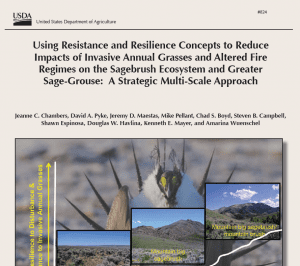Resistance & Resilience
View article.
This study tested the stress-gradient hypothesis (SGH) in observations of 75 sites along overlapping water and heat stress and disturbance gradients. As stress-disturbance levels increase, sagebrush-herbaceous plant facilitation levels increase, the landscape will become increasingly aggregated as a product of necessary facilitation between sagebrush and herbaceous plants. This aggregation decreases the individual resilience of the native herbaceous plants, increases the competition from invasive plants, and decreases the overall stability and resilience of the sagebrush steppe ecosystem.
View field guide.
This field guide provides a framework for rapidly evaluating post-fire resilience to disturbance, or recovery potential, and resistance to invasive annual grasses, and for determining the need and suitability of the burned area for seeding. The framework identifies six primary components that largely determine resilience to disturbance, resistance to invasive grasses, and potential successional pathways following wildfire, as well as the information sources and tools needed to evaluate each component.
The components are: (1) characteristics of the ecological site; (2) vegetation composition and structure prior to the wildfire; (3) fire severity; (4) post-wildfire weather; (5) post-wildfire management, especially grazing; and (6) monitoring and adaptive management.
The tools provided are: (1) a conceptual model of the key components that largely determine resilience to disturbance and resistance to invasive annual grasses of the burn area, (2) a guide to evaluate post-wildfire severity, (3) indicators to estimate pre-wildfire plant composition and structure if not known, and (4) an evaluation score sheet to rate an area’s potential post-wildfire resilience to disturbance, resistance to invasive annual grasses and, thus, the need for seeding and probability of success.
View field guide.
This field guide identifies seven primary components that largely determine resilience to disturbance, as well as resistance to invasive grasses and plant succession following treatment of areas of concern. An evaluation score sheet is included for rating resilience to disturbance and resistance to invasive annual grasses and the probability of seeding success.
View fact sheet.
This fact sheet from the Sage Grouse Initiative discusses a new soils product that provides the ability to depict potential ecosystem resilience and resistance across the range of sage-grouse using soil temperature and moisture regimes.
View report.
This report provides a strategic approach for conservation of sagebrush ecosystems and greater sage-grouse that focuses specifically on habitat threats caused by invasive annual grasses and altered fire regimes. It uses information on (1) factors that influence sagebrush ecosystem resilience to disturbance and resistance to invasive annual grasses and (2) distribution, relative abundance, and persistence of sage-grouse populations to develop management strategies at both landscape and site scales.
View report.
This review synthesizes the state of knowledge on fire effects on vegetation and soils in semi-arid ecosystems in the Great Basin Region. It identifies knowledge gaps and presents a framework for predicting plant successional trajectories following wild and prescribed fires and fire surrogate treatments. Possibly the three most important ecological site characteristics that influence a site’s resilience (ability of the ecological site to recover from disturbance) and resistance to invasive species are soil temperature/moisture regimes and the composition and structure of vegetation on the ecological site just prior to the disturbance event.
View article.
This study investigated factors controlling cheatgrass invasions in sagebrush systems, including the influence of livestock grazing. It found that cheatgrass invasion was limited where few and small gaps existed between bunchgrass and where biological soil crusts were present to stabilize soil and limit cheatgrass establishment. Results also suggest that grazing reduces invasion resistance by decreasing bunchgrass abundance and trampling biological soil crusts. Managing grazing to ensure abundance and variety of bunchgrasses and to preserve biological soil crusts could help restore sagebrush ecosystems.
View article.
This study compared unburned and burned sites to determine how cheatgrass and native wheatgrass abundance and distribution varied. Wheatgrass density increased in high-nutrient areas. Soil cores from burned microsites were also transplanted to a controlled area and seeded with either wheatgrass or cheatgrass to determine microsite effects on plant establishment and growth. There were differences in microsite soil properties, which were not affected by plant growth, and differences in growth but not establishment of grass seeds. Microsites are likely important for post-fire resistance of rangeland to cheatgrass establishment.
View synthesis.
This synthesis investigates the resistance and resilience differences among the cold and hot desert shrublands of North America. Differences are largely determined by spatial and temporal patterns of productivity but also are affected by ecological memory, severity and frequency of disturbance, and feedbacks among invasive species and disturbance regimes. Strategies for preventing or managing invasive plant/fire regimes cycles in desert shrublands include: 1) conducting periodic resource assessments to evaluate the probability of establishment of an altered fire regime; 2) understanding ecological thresholds associated within invasion resistance and fire resilience that characterize transitions from desirable to undesirable fire regimes; and 3) prioritizing management activities based on resistance of areas to invasion and resilience to fire.
- « Previous
- 1
- …
- 8
- 9
- 10




